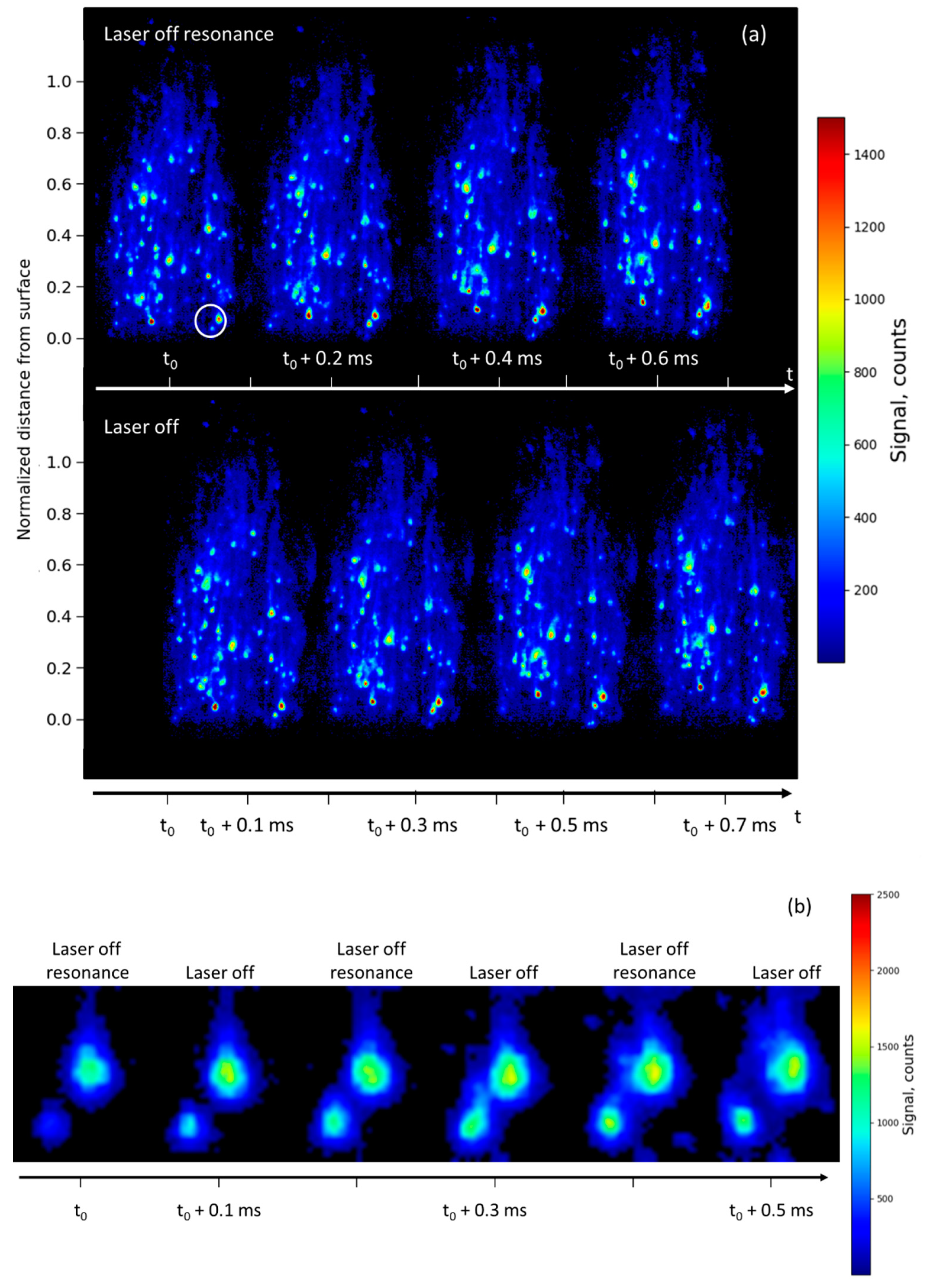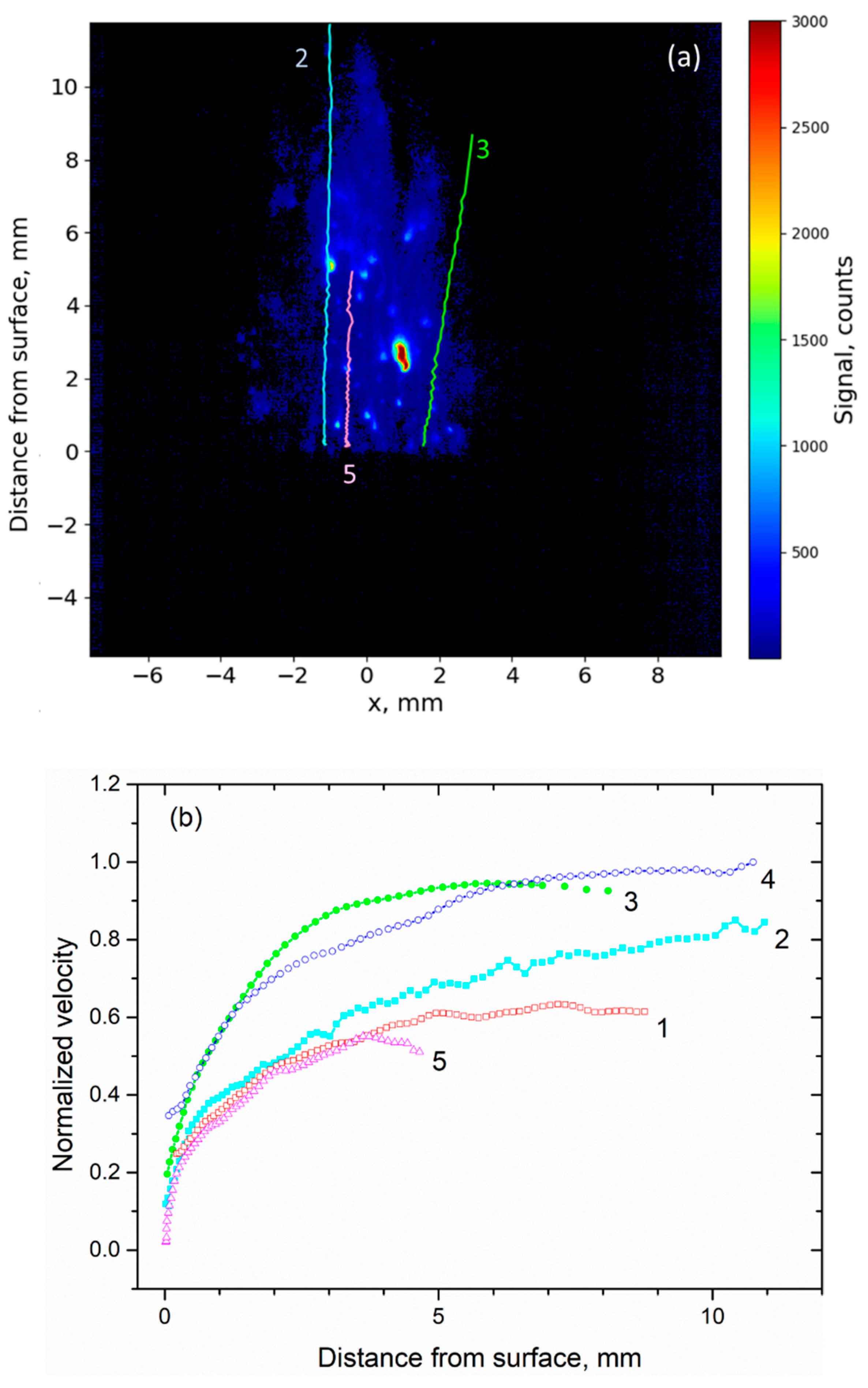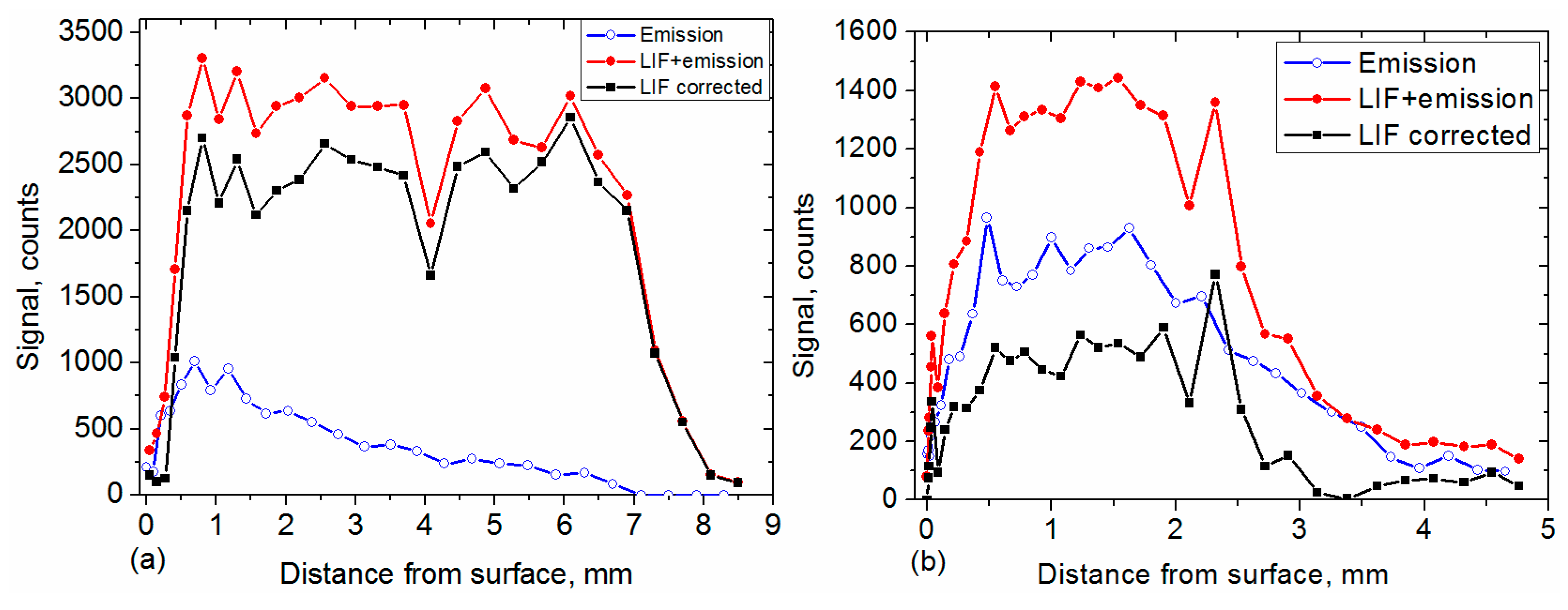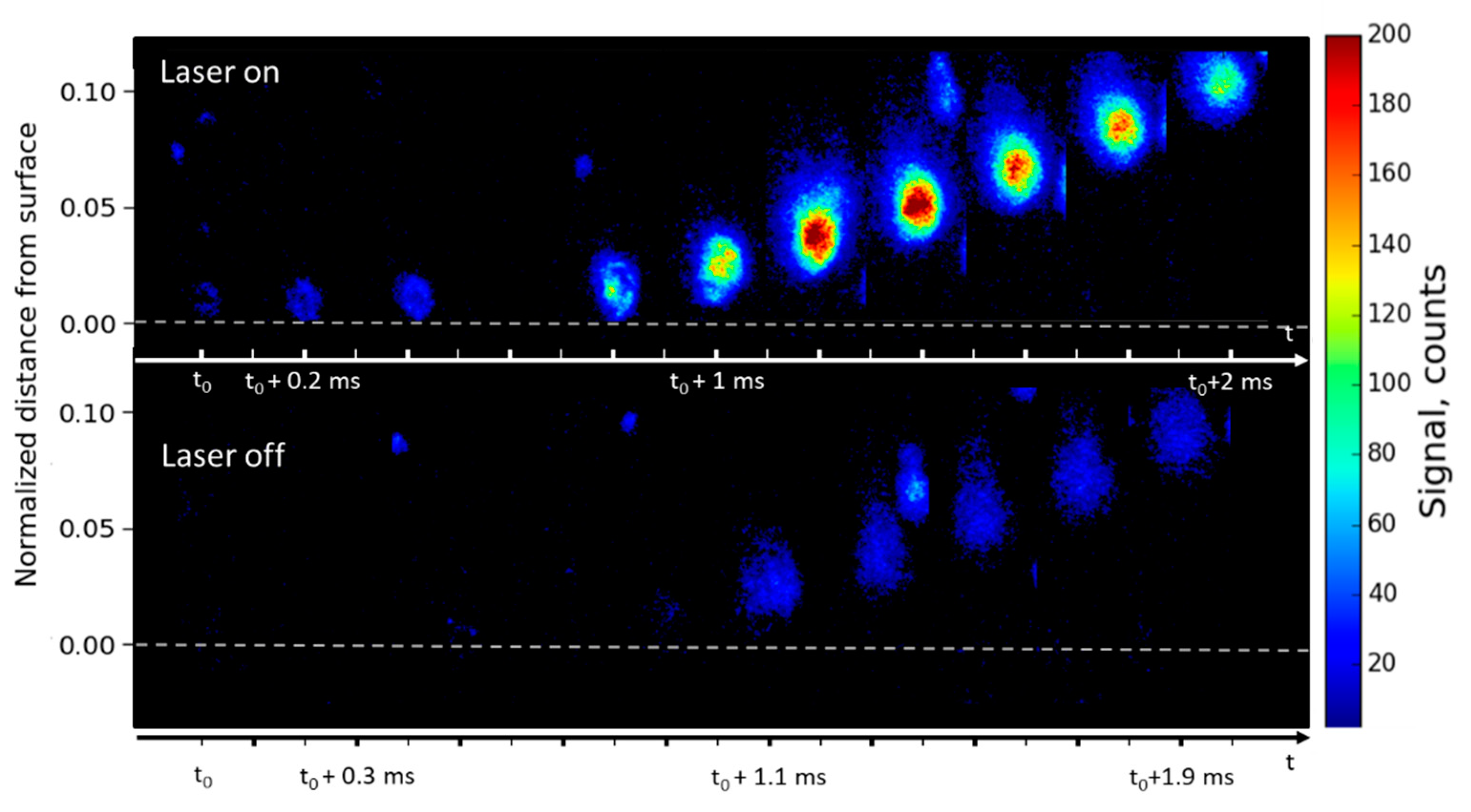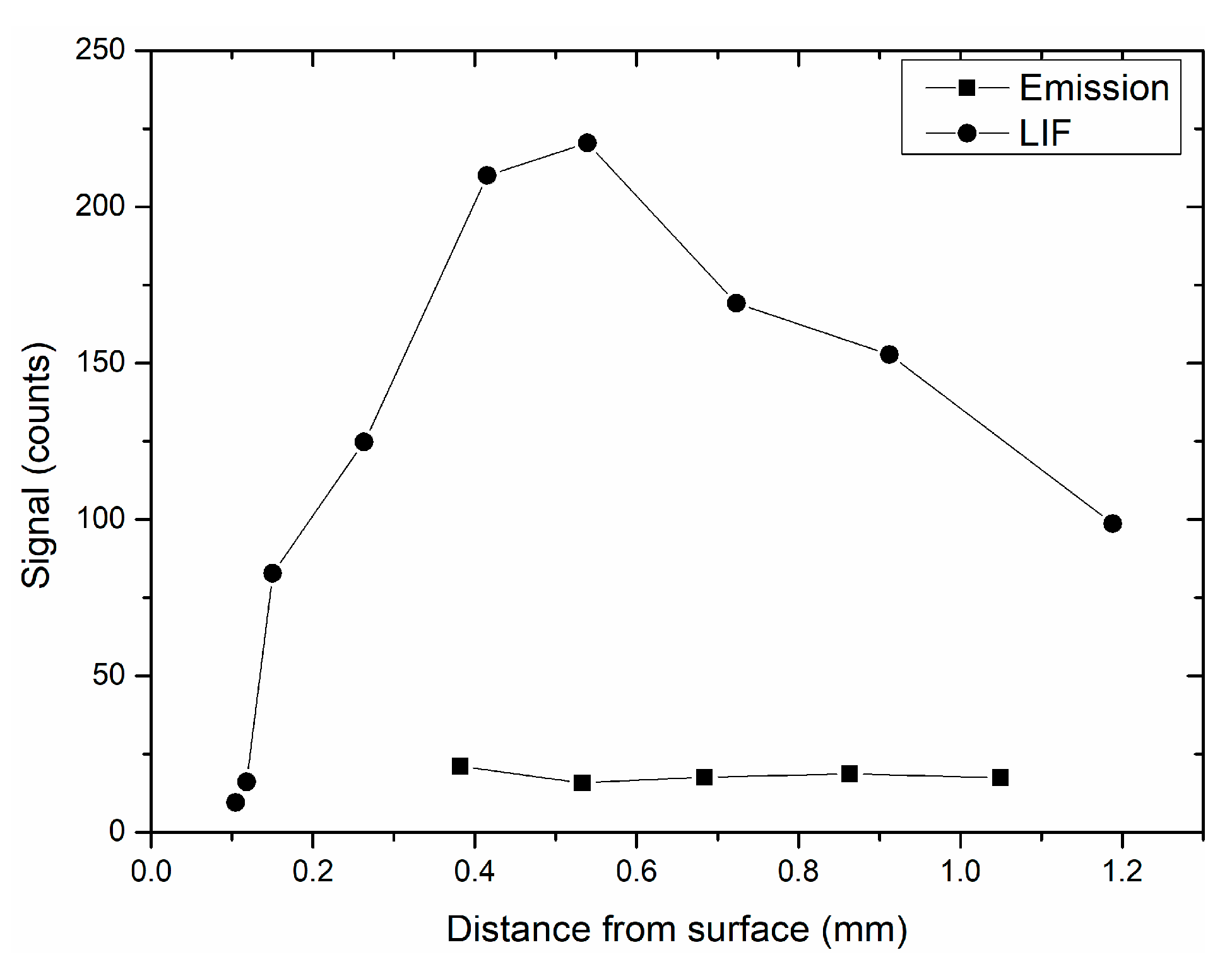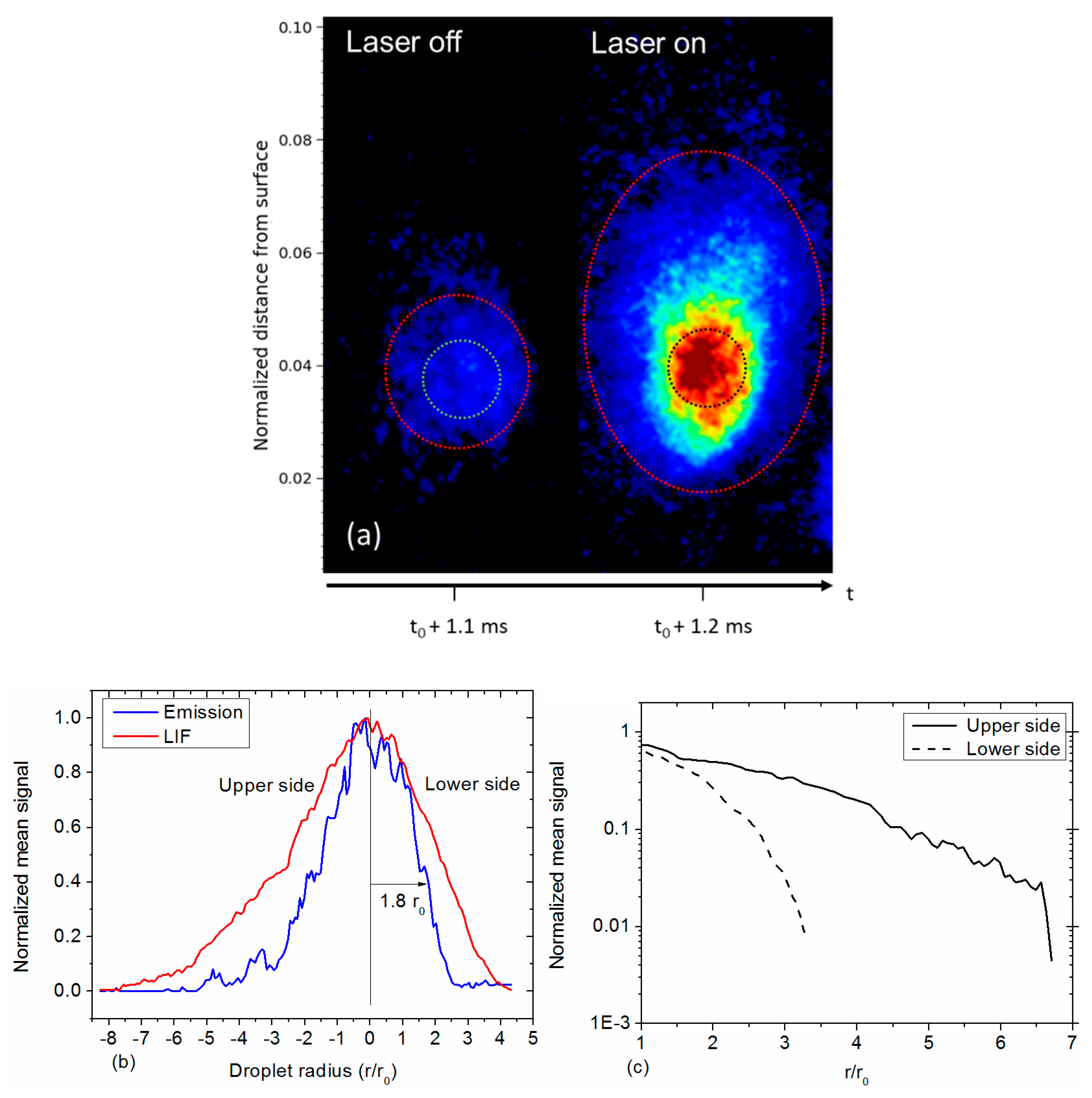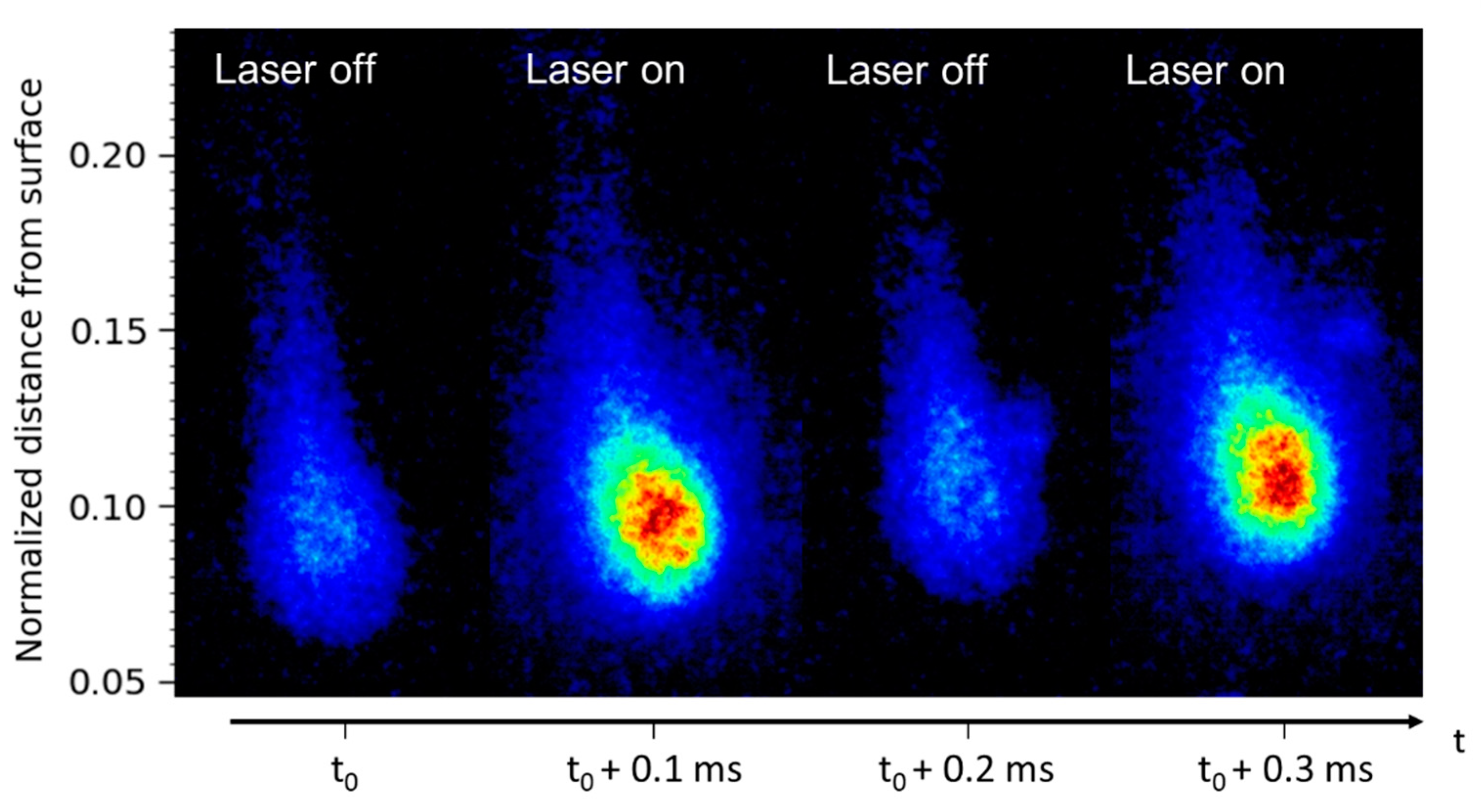3.1.1. LIF and Emission Image Analysis
Spectral investigation was performed in the UV range in order to reduce interference with the blackbody radiation. The fluorescence signal was detected far away from the excitation wavelength to filter elastic light scattering. Prior to Al-PLIF measurements in solid-propellant flames, spectroscopic studies have been performed under steady-state conditions inside two dedicated evaporation chambers, namely a resistive heater evaporation chamber and a laser vaporization chamber [
19,
20]. Both systems were used in order to validate our excitation/detection scheme (309/(394–396) nm) and to quantify the pressure and saturation effects on signal behavior. A theoretical model including quenching and saturation effects has been elaborated in [
20]. The model was validated through a number of experiments, among them fitting the spectral excitation profiles with computed profiles and measuring the fluorescence decay time to retrieve collisional parameters, in a dedicated experiment in the resistive heater evaporation chamber. A fluorescence quantum yield of 2% at 0.1 MPa (N
2) and 2500 K was measured, which was extrapolated to 0.15% at 1.5 MPa.
We recall here that the image acquisition frequency was twice the laser repetition rate. Two sequences of four images are presented in
Figure 2a as a function of time. The top sequence shows the images recorded with the laser on and the bottom sequence shows background emission (without laser). Expanded views of a luminous particle observed in both emission and LIF images are shown in
Figure 2b. Let us recall that the laser sheet crossed the flame from right to left in each image. Let us also note that in all the spatio-temporal images (distance versus time), distance to the surface has been normalized to the total flame height.
Allocation of the evaporating Al droplet was made possible by comparing the alternating emission and LIF image sequence. The LIF signal was observed in the top sequence (around 3000 counts) originating from some droplets in the flame (bright spots) emanating from the burning surface, whereas the emission level was lower (750 counts). The resulting signal-to-noise ratio (SNR) was four. As a matter of fact, the LIF signal (laser tuned on resonance with the Al transition) was unambiguously attributed to a liquid Al droplet surrounded by a cloud of gaseous Al atoms evaporating at high temperature during and after ignition. The strong intensity of the LIF signal resulted from the high density of atoms in liquid particles burning at high temperature.
In such a multiphase flow, discrimination between solid, liquid, and vapor phases is not straightforward. However, the LIF signal originating from the liquid phase will be far more intense than the gas-phase signal according to the relative atom number density (superimposed signals). Moreover, the LIF signal is a good marker for phase transformation of the Al particle from its solid phase to its liquid phase (melting point of 930 K) and to evaporating Al (boiling point of 2745 K), which is burning. The flame is located in the droplet area since evaporating Al atoms react with the ambient gases [
21,
22] to form new species including alumina (Al
2O
3). Our imaging technique enables Al transformation inside the combustion to be monitored.
On the other hand, emission radiation mainly results from the thermal emission (blackbody radiation) of the hot particle surfaces, from the gas-phase flame, and from oxide smoke (Al
2O
3) forming clouds dispersed in the flame. Al
2O
3 is assumed to be formed and to be molten at first (melting point at 2300 K). According to a new theoretical combustion prediction [
21,
22] a homogeneous alumina nucleation process is taking place inside the hot flow around the aluminum droplets (which can be very small) by oxidation of the Al gas. Chemical phase transformation ends when temperature decreases so that species condensate. Although it was not done here, emission radiation may be studied in more detail spectroscopically, to reveal the chemical nature of all irradiating species [
20].
The images in
Figure 2a exhibit a weak and inhomogeneous background (light blue) spread all over the flame (300–400 counts). The background is stronger in the vicinity of the fluorescent particles and extends across the whole flame. It results from radiation of hot gases and also originates from the hot and fine alumina (Al
2O
3) smoke. Al
2O
3 nanoparticles are spread in the flow as soon as they are formed on the Al droplet surface by the oxidation reaction, thus contributing to the luminous flame background.
Allocation of the different phases (solid nanoparticles, liquid droplet, gaseous Al) was made possible by comparing the alternating emission and LIF images sequences displayed in
Figure 2b. The droplet core is allocated in emission at t
0. Then, it strongly fluoresces in the middle image (SNR of four) due to the presence of a high density of aluminum, in its liquid and gaseous phases. The central zone is circled in white and does not change in size through the three displayed images. Around the mostly liquid droplet core (visible on the emission image), the larger extension of the LIF signal unambiguously allocates gaseous Al atoms, which extend to fill the red circle with some additional clouds upward and downward also exhibiting fluorescence, although barely visible. By comparing the mean LIF-signal level measured in this area (250 counts) to the one obtained in controlled experimental conditions with a known density of atoms, and by using the model described in [
19] to account for the differences in pressure, temperature, and laser intensity, the density of gaseous atoms was estimated to be about 10
12 cm
−3.
The smoke emission (circled in blue) above the droplet narrows upwards to form a plume. Although not exactly identical because of the time delay, it has very similar behavior in the three images, showing that nearly no gaseous aluminum is present in this region, and providing a sketch of its evolution. Each image from
Figure 2b shows that smoke emission and fluorescence are dragging upward, since both Al vapor and fine Al
2O
3 nanoparticles flow inside the flame gases [
21,
22]. Nevertheless, the velocity is moderate (
Section 3.1.2.). Finally, due to the very short duration of Al atom fluorescence (<10 ns) that freezes the physicochemical changes of the lightning particle and the recording of alternate images, it is possible to identify gaseous Al-atom location with a high spatial and temporal resolution.
Figure 3 presents a sequence of four images of the same burning propellant at a higher pressure of 1.5 MPa with and without laser. As the pressure increases, the LIF/emission signal ratio becomes smaller. The bean-shaped LIF particle observed (on the right-hand side of the flame) is seen to produce a huge LIF signal, likely due to its higher temperature and larger size, probably as a result of an agglomeration process.
For the majority of droplets, the contrast becomes lower as pressure increases. A background emission (light blue) is still observed in
Figure 4, all over the flame. It is as intense as in
Figure 2 and the emission remains restricted to the alumina particles region, all shaped as plumes.
In
Figure 4, the laser is detuned far away from Al absorption line center (by 500 pm, laser off resonance). In
Figure 4a, four images are recorded with laser off resonance (upper sequence) and four emission images are recorded without laser (bottom sequence). Similar signal levels are obtained in both cases confirming that elastic light scattering from particles is small. Hence, only light emission from gas-phase and condensed/molten particles (including nanoparticles) interfered with the LIF signal from Al atoms.
A close-up sequence is presented in
Figure 4b, by extracting expanded views of a droplet (white circle in
Figure 4a). It does not matter that the laser is on and off because spontaneous emission is dominant in all images, as already mentioned. However, it is interesting to observe that the signal changes slowly enough that the sampling rate is sufficient to provide a good insight into the phase transformation process, even though the sampling rate is not high enough to follow the chemical reactions. The latter have reaction rates typically in the range 10
−6–10
−9 s, and even shorter, whereas the frame-to-frame time interval of 10
−4 s is available with our laser system [
7]. In
Figure 4b, the signal evolution of both particles is mainly driven by temperature changes and is seen to increase versus time with smoke production during the combustion process (increasing halo).
3.1.2. Droplet Trajectory and Velocity Measurement
Such a high-speed Al-PLIF technique is a powerful tool since analysis of the images gives access to important information such as:
Trajectories of the molten aluminum droplets;
Velocities as a function of distance from the propellant surface;
Lifetimes of the Al droplets evolving in the flame from the moment of fluorescence signal appearance (probably ignition) to its extinction, providing a way to measure their burning properties.
The potential of our technique for measuring droplet trajectory is illustrated in
Figure 5. The location of a fluorescent droplet is followed manually from one image to another. The resulting droplet trajectories for three particles are shown in
Figure 5a. The measurement repetition rate is sufficiently fast to allocate two successive positions of the droplet (according to its velocity). Between two consecutive images, a droplet would move by only a few pixels. Given the size of the image (17 mm = 768 pixels), it is thus possible to follow a droplet over about 100 images (i.e., over 10 ms). Temperature rises just above the propellant, and particles are molten all across the flame. The trajectory of Particle 2 is remarkably straight and vertical (light blue). The droplet is still visible up to 11 mm above the propellant surface due to its size and brightness. The solid-propellant burning surface location is measured on the image (followed on a camera).
The vertical velocity of a particle is retrieved by measuring its positions in the images and differentiating these. To illustrate the previous procedure, the resulting velocities of five particles are shown in
Figure 5b. All droplets except droplet 5 are located on the lateral border of the flame. First, particles are extracted from the surface of the propellant either with a velocity close to zero (particles 2 and 5) or already with some initial speed (particles 1, 3, 4). Either way, they then experience acceleration during the first 2 millimeters following release (< 4 mm). The velocity profiles are strongly dependent on their size due to the drag effect. Only smaller particles are able to follow the flow whereas larger ones are slowly dragged. The two particles exhibiting a steep acceleration over the first mm and the highest velocity are expected to be the smallest. Velocities reach a plateau over the last 7 mm. This asymptotic value depends on the droplet size, assuming that flame temperature and gas velocity are unchanged.
Al-droplet velocity measurements were also performed using the shadowgraphy technique for—the same solid propellant flame burning at 1.2 MPa. Shadowgraphy images are limited to a field of view of only 3 × 3 mm
2 and recorded with a lower sampling rate (from 3 to 6 kHz). The larger field of view and higher sampling rate of the LIF technique improve the trajectory analysis and enlarge the measurement domain, while being chemically selective. Good agreement was previously found between the two measurement techniques [
23].
Droplet size was measured with shadowgraphy imaging with, as previously noted, there being a strong correlation between velocity profiles and droplet size. In the LIF image, the signal originates both from liquid and vapor, the latter enlarging the particle spatial extension, so that the method is not well adapted to droplet sizing. Nevertheless, comparing the velocity profiles drawn from emission/LIF (
Figure 5b) and shadowgraphy, it is possible to evaluate the size for previous droplets in the range of 80–170 µm as previously published [
23]. The diameters estimated from emission images were in the 150–260 µm range for particles 1 to 5; thus the particle size is definitely attributable to its hot and luminous center. One can notice that emission images overestimate the size of the droplets (1.8 r
0), as does LIF to an even greater extent, therefore confirming that the gaseous phase has a noticeable contribution to both images (see
Section 3.2).
3.1.3. Statistical Analysis for Droplet Velocity
In order to increase the validity of the analysis, a large number of trajectories had to be reconstructed to statistically describe the droplet velocity across the full flame height, and throughout the full combustion duration. Because of the large amount of data to process, analysis involved using algorithms to automatically detect droplets and reconstruct their trajectories, (approximatively 700,000 droplets for a two-second experiment). Preliminary results of the droplet detection algorithm applied to the above propellant images are presented in this section (for a combustion test at 1.2 MPa). Because particles were detected over a long period of time, regression of the surface cannot be disregarded. Therefore, prior to using the droplet detection algorithm, the position of the solid-propellant burning surface was evaluated over time and the image was vertically translated so that the surface stayed at a fixed level on the vertical scale (at pixel 700 here). This provides a common spatial reference for all images. The algorithm used to detect particles is the maximally stable extremal regions algorithm, namely MSER [
24]. This was previously used for droplet detection of shadowgraphy images [
23]. It consists of binarizing the images with different signal-level thresholds and detecting the spatial regions whose shape remains stable. The algorithm application is illustrated in
Figure 6. It was used in the current study to retrieve the position of the particles.
Several parameters affect the sensitivity of the MSER algorithm. Parameters were adjusted by comparing MSER prediction with manual spotting of the droplets. The goal was to detect the most hand-picked droplets (i.e., retrieve as many “real droplets” as possible) without generating a high number of false negatives. The best performance level was achieved using different parameters for the LIF and emission images. This probably resulted from the fact that the LIF images contain droplets with a very strong signal, leading to an increase of the image contrast and a flattening of the less intense droplets. Overall, 85% of the hand-selected particles were detected by MSER, with a 16% false-positive rate. This is a very good level of detection performance. The false-positive rate was much better than that usually obtained for shadowgraphy-image analysis (in the range 40–55% in [
23]).
Applying the algorithm to the whole combustion run (2700 images) yielded a total of 64,000 detected objects, one droplet being detected several times on successive images. The distribution of droplets as a function of signal level is shown in
Figure 7 for the LIF and emission images. More droplets are found in the LIF images than in the emission images (34,000 vs. 30,000), mainly due to the algorithm being more sensitive in the first case, as previously discussed.
The droplet emission signal did not exceed 1400 counts (
Figure 7; blue lines) in the emission images. Therefore, droplets exhibiting a signal higher than 1400 counts in the LIF images were only the fluorescing ones. This threshold yielded 690 fluorescent droplets, compared to 63,310 droplets obtained in emission (summing the emission droplets in the LIF and emission images). Thus, it was an easy initial way to separate the LIF droplets from the emission droplets inside the LIF images, though by no means exhaustive. Indeed, many LIF droplets had a signal below 1400 counts. A better way of distinguishing the LIF and emission droplets would be to reconstruct the droplet trajectories and check for the increase in signal of the droplets in the LIF images. This is the method that will be preferentially used in the future.
Since the MSER algorithm gives the positions of the detected droplets, it was possible to provide the horizontal and vertical distributions of the number of emission and LIF droplets, as shown in
Figure 8.
The horizontal distribution extends from 2 to 4 mm for a total of 6 mm in
Figure 8a. The initial width of the propellant sample is 5 mm. The distribution of emission droplets exhibits a hole in the flame center with a loss of about 30% of detected droplets. This might be due to the higher density of smoke in that region, which may attenuate the droplet radiation signal. Interestingly, the distribution peaks are different for the emission and LIF droplets: the emission distribution peaks at 0 mm whereas LIF distribution peaks at 1.5 mm. This was attributed to laser sheet absorption by the smoke as it propagated through the flame.
The vertical distribution extends from 0 to 12.5 mm in
Figure 8b. The number of droplets increases from 0 to the peak value reached at 1.9 mm, and exponentially decreases to 12.5 mm. The increase from the surface to h = 2 mm lasts 2–4 ms. The very first droplets leaving the surface are seen over a very short distance, 200–500 µm. The LIF and emission distributions reach maxima at the same distance from the surface. The location of the maximum probably corresponds to a region in which temperature is higher, on average, since dilution by surrounding N
2 in the combustion chamber reduces hot-gas temperature further away from the solid-propellant burning surface. The signal is persistent until the aluminum is totally consumed, the lack of fuel lowering the reaction rate [
21,
22]; thus, very few LIF droplets can be seen above 10 mm from the burning surface (reached after about 10 ms spent in the hot-gas flow). This should indicate that the combustion of the droplets is over at this height. This will be verified with a more robust and accurate image analysis procedure including a better distinction between LIF and emission droplets, which will enable more LIF droplets to be detected. Experimentally, we also plan to increase the intensity of the laser and to shorten the duration of the intensifier gate from 100 to 40 ns, in order to increase the LIF intensity and better eliminate emission, thus simplifying the image analysis.
3.1.4. Vertical Evolution of the LIF and Emission Signals
The evolution of the signal with and without laser is shown as a function of distance above the burning surface in
Figure 9. Particles 3 and 5 were chosen for this study since they exhibited different velocity profiles in
Figure 5. However, analysis of their behavior is representative of many other particles among the large number observed and treated in our images, due to the above treatment.
Signal amplitude was averaged over an area of 3 × 3 pixels located in the brightest zone of the droplet. The emission part of the (LIF + emission) signal (●) can be removed by interpolating the emission intensity (
○, recorded at a delay of 100 µs) and subtracting it from the LIF + emission signal, thus providing the pure LIF signal. Background-subtracted Al-PLIF signal was divided by the laser mean profile recorded from the acetone-fluorescence image to correct the LIF signal for the spatial inhomogeneity over the laser-sheet height. Signal was thus corrected for the spatial distribution of the laser energy (■). Comparisons between the vertical profiles of emission and LIF signals shown in
Figure 9, provide clear evidence of frame-to-frame fluctuations of the LIF signal, whereas the emission signal is more stable for Particle 3 but fluctuates for Particle 5. Fluctuation of the LIF signal partly results from shot-to-shot fluctuations in laser power (in the range of ± 15%). In addition, larger fluctuations may originate from the location of the droplet inside the laser sheet thickness on top of the physical fluctuation resulting from combustion itself. The latter is indicated by emission which simply follows temperature. The laser sheet is currently 100 µm thick. As expected, the laser sheet location is subject to beam steering resulting from the gradient of the refractive index induced by temperature gradients. The unsteady nature of the flame may induce an intermittent pulsation of the laser sheet. Therefore, the droplet may be just inside the laser sheet at one point and slightly out of it at the following point. Signal alternation between “in” and “slightly out” may appear on the vertical profile since the map flips with the flame. Therefore, the LIF signal may also change accordingly, as sometimes seen in
Figure 9. We plan to use a thicker laser sheet in future experiments to overcome this artefact.
Particles are first ejected in the hot-gas flow and then start burning by emitting fluorescent light from both the liquid and surrounding gas phase, but with strong contrast. The vertical profile shows that LIF signal is already visible at a height of 200 µm and then increases significantly, as observed in
Section 3.2. The signal level is driven by ignition, and thus temperature, across the flame. In the case of the fast (and small) Particle 3 (green,
Figure 5a), the LIF signal is strong and constant, indicating a high Al concentration which is persistent because the particle is leaving the flame at the side, thus maintaining a constant liquid concentration. For the slower Particle 5 which is located near the flame center, the LIF signal is smaller with roughly the same level of emission (800 counts) as Particle 3, indicating less liquid (and gaseous) Al percentage inside the hot and burning particle (pink,
Figure 5a) that already extinguishes at 4 mm in height.
In
Figure 9, emission and LIF signals reach a maximum value between 0.5 and 1 mm above the burning surface. This is consistent with the distribution of fluorescent droplets and emitting droplets obtained in
Figure 8b.



